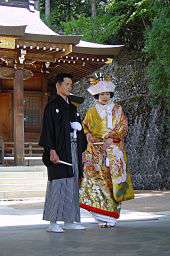Formal wear
| Part of a series on |
| Western dress codes and corresponding attires |
|---|
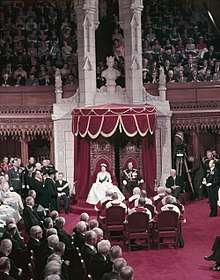 |
|
Supplementary
|
|
Legend: |
Formal wear, formal attire or full dress is the traditional Western dress code category applicable for the most formal occasions, such as weddings, christenings, confirmations, funerals, Easter and Christmas traditions, in addition to certain audiences, balls, and horse racing events. Formal attire is traditionally divided into formal day and evening attire; implying morning dress before 6 p.m., and white tie (dress coat) afterwards. Generally permitted other alternatives, though, are the most formal versions of ceremonial dresses (including court dresses, diplomatic uniforms and academic dresses), full dress uniforms, religious clothing, national costumes, and most rarely frock coats. In addition, formal attire may be instructed to be worn with official orders and medals.
With background in the 19th century, the protocol indicating particularly men's formal attire have remained virtually unchanged since the early 20th century, and remains observed so in certain settings influenced by Western culture: notably around Europe, the Americas, and Australia, in addition to Japan. For women, although fundamental customs for ball gowns (and wedding gowns) likewise apply, changes in fashion have been more dynamic. Optional conventional headgear for men is the top hat, and for women picture hats etc. of a range of interpretations.
"Formal attire" being the most formal dress code, it is followed by semi-formal attire, equivalently based around daytime stroller, and evening black tie i.e. dinner suit (tuxedo), and evening gown for women. The lounge suit and cocktail dress in turn only comes after this level, associated with informal attire. Notably, if a level of flexibility is indicated (for example "uniform, morning coat or lounge suit", as seen to the royal wedding of Prince Harry and Meghan Markle in 2018), the host tend to wear the most formal interpretation of that dress code in order to save guests the embarrassment of out-dressing.
Since the most formal versions of national costumes are typically permitted as exceptions to the uniformity in Western formal dress code, conversely, since most cultures have at least intuitively applied some equivalent level of formality, the versatile framework of Western formal dress codes open to amalgation of international and local customs have influenced its competitiveness as international standard. From these social conventions derive in turn also the variants worn on related occasions of varying solemnity, such as formal political, diplomatic, and academic events, as well as certain parties including award ceremonies, high school proms, dance events, fraternal orders, etc.
Dress codes
The dress codes counted as formal wear are the formal dress codes of morning dress for daytime and white tie for evenings. Although some consider strollers for daytime and black tie for the evening as formal, they are traditionally considered semi-formal attires, sartorially speaking below in formality level.
The clothes dictated by these dress codes for women are ball gowns. For many uniforms, the official clothing is unisex. Examples of this are court dress, academic dress, and military full dress uniform.
Morning dress
Morning dress is the daytime formal dress code, consisting chiefly for men of a morning coat, waistcoat, and striped trousers, and an appropriate dress for women.
White tie
The required clothing for men, in the evening, is roughly the following:
- Formal trousers, uncuffed, with stripes on leg seams
- White piqué front or plain stiff-fronted shirt with a detachable wing collar, cuff links and shirt studs
- White piqué bow tie
- White piqué vest (waistcoat)
- A (dress) tailcoat
- Black patent leather court shoes
- Accessories
Women wear a variety of dresses. See ball gowns, evening gowns, and wedding dresses. Business attire for women has a developmental history of its own and generally looks different from formal dress for social occasions.
Supplementary alternatives
In general, each of the supplementary alternatives apply equally for both day attire, and evening attire.
Ceremonial dress
Including court dresses, diplomatic uniforms, and academic dresses.
Full dress uniform
Religious clothing
 First native Catholic parish priest from the Belgian Congo, wearing a Roman cassock with the standard 18 buttons (Gazet van Antwerpen, 2 September 1906).
First native Catholic parish priest from the Belgian Congo, wearing a Roman cassock with the standard 18 buttons (Gazet van Antwerpen, 2 September 1906). Catholic Cardinal Tarcisio Bertone wearing a tropical white cassock trimmed in cardinalatial scarlet in Santo Domingo, Dominican Republic (2006).
Catholic Cardinal Tarcisio Bertone wearing a tropical white cassock trimmed in cardinalatial scarlet in Santo Domingo, Dominican Republic (2006).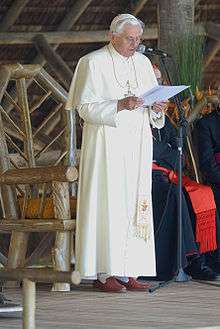 Pope Benedict XVI in white cassock (sometimes though unofficially called a simar) with pellegrina and fringed white fascia (2007).
Pope Benedict XVI in white cassock (sometimes though unofficially called a simar) with pellegrina and fringed white fascia (2007).- Justin Welby, Anglican Archbishop of Canterbury, and Kim Geun-Sang, Anglican Primate of the Anglican Church of Korea (2013).
- Chief Rabbi Shlomo Amar of Jerusalem, Israel (right) with Jewish scholar Joseph J. Sherman (left) (2014).
Folk costume
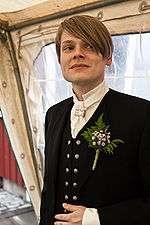
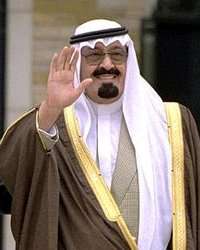
In Western formal state ceremonies and social functions, diplomats, foreign dignitaries, and guests of honour wear Western formal dress if not wearing their own national dress.
Many cultures have formal evening and day dress, for example:
- Av Pak — both traditional and modern embroidered blouse worn by women in Cambodia at Special occasion, traditional festival and Formal show.
- Barong Tagalog — worn by men in the Philippines.
- Bisht — worn by men with thawb and shmagh or ghutrah and agal in formal and religious occasions, e.g. Eid, in some Eastern Arab countries like (Saudi Arabia, Iraq, Kuwait, UAE, Qatar, Bahrain and others).
- Batik shirt — worn by men and women in Indonesia.
- Bunad — worn as formal dress by women and men in Norway.
- Changshan — a long male version of the qipao, which originated during the Qing Dynasty. It can be of cotton for ordinary wear, or of silk for those within aristocratic families. Beneath the changshan, the male generally wears white mandarin-collar long-sleeve shirt and a pair of dark colored long pants. Like the qipao, this changshan male gown has slits on both sides (at least knee level) as well. Worn nowadays either by Chinese men in the martial arts world, or as attire for weddings to match the qipao the bride wears. The qipao and changshan originated as Manchu dresses which government officials, but not ordinary civilians, were required to wear under the Qing Dynasty's laws. Gradually, the general non-official Han Chinese civilian population not voluntarily shifted from wearing traditional Chinese hanfu clothing to the qipao and changshan.
- Cheongsam — a modern female variation of the Qing Dynasty silk dress, characterized by a high mandarin collar, and side open slits of varying lengths. It can be sleeveless, short, elbow or long sleeve, and has been adopted by most Chinese women as a Chinese wear, depending on materials and occasions.
- Daura-Suruwal — worn as formal dress by men in Nepal.
- Dashiki — worn by men in West African countries.
- Dhoti — worn by men in Pakistan, India, Bangladesh, the Maldives, and Tamil men in Sri Lanka.
- Folkdräkt — worn as formal dress by women and men in Sweden.
- Hátíðarbúningur — worn by men in Iceland to formal events such as state dinners and weddings.
- Highland dress with Scottish kilt — worn as formal dress by men in Scotland or of Scottish descent
- Kebaya — worn by women in Malaysia and Indonesia.
- Mao suit, worn as diplomatic uniform and evening dress by officials of the People's Republic of China
- Sari — worn by women in India, Nepal, Bangladesh, Pakistan and Sri Lanka.
- Shalwar kameez — worn by both men and women in Pakistan, India and Bangladesh.
- Sherwani worn by men in India and Pakistan
Frock coat
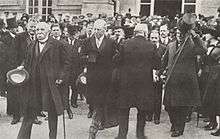
Although ceased as a protocol-regulated required formal attire at the British royal court in 1936 at the order of the short-reigning King Edward VIII, the frock coat - embodying the background for all contemporary civil formal wear - has not altogether vanished. Yet, it is a rarity mostly confined to infrequent appearances at certain weddings.
The state funeral of Winston Churchill in 1965 included bearers of frock coats.[1]
To this day, King Tupou VI of Tonga (born 1959) has been a frequent wearer of frock coats at formal occasions.
As an example of more recent fashion, Prada's autumn editions of 2012 heavily embraced frock coats.
Gallery
Morning dress
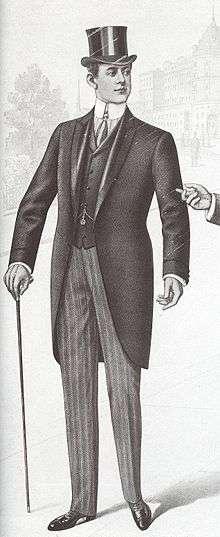 Morning dress in 1901
Morning dress in 1901 Sir John Goodwin and Lady Goodwin together with Neil Campbell and his wife, walking over the Grey Street Bridge in morning dress, top hats and spats (1931).
Sir John Goodwin and Lady Goodwin together with Neil Campbell and his wife, walking over the Grey Street Bridge in morning dress, top hats and spats (1931). Torsten Nothin, Gunnar Asplund, Crown Prince Gustav Adolf, Prince Eugen and Yngve Larsson at the inauguration of Skogskyrkogården, Stockholm, Sweden (1940).
Torsten Nothin, Gunnar Asplund, Crown Prince Gustav Adolf, Prince Eugen and Yngve Larsson at the inauguration of Skogskyrkogården, Stockholm, Sweden (1940).
 Men in morning dress and women in wedding gowns at wedding (1929)
Men in morning dress and women in wedding gowns at wedding (1929)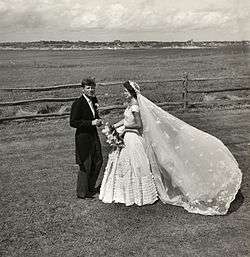
White tie
- Caricature of William Lygon, 7th Earl Beauchamp in Vanity Fair (1899).
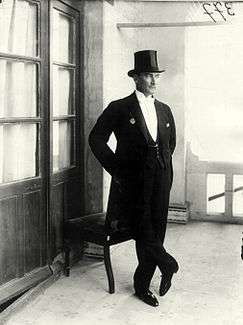 Mustafa Kemal Atatürk in evening white tie formal wear (1923)
Mustafa Kemal Atatürk in evening white tie formal wear (1923) Queen Elizabeth II (in ball gown) and Prince Philip (full dress uniform) before the formal (full dress) opening of the Parliament of Canada (1957), surrounded by participators of varying degrees of formal attire (morning dress, white tie etc.), presumably in accordance with their functions or time of arrival and departure.
Queen Elizabeth II (in ball gown) and Prince Philip (full dress uniform) before the formal (full dress) opening of the Parliament of Canada (1957), surrounded by participators of varying degrees of formal attire (morning dress, white tie etc.), presumably in accordance with their functions or time of arrival and departure.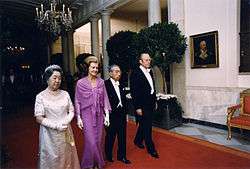 President of the United States Gerald Ford, First Lady Betty Ford, Japanese Emperor Hirohito and Empress Nagako (the men in white tie) during a state dinner (1975).
President of the United States Gerald Ford, First Lady Betty Ford, Japanese Emperor Hirohito and Empress Nagako (the men in white tie) during a state dinner (1975).
See also
| Wikimedia Commons has media related to Formal clothing. |
